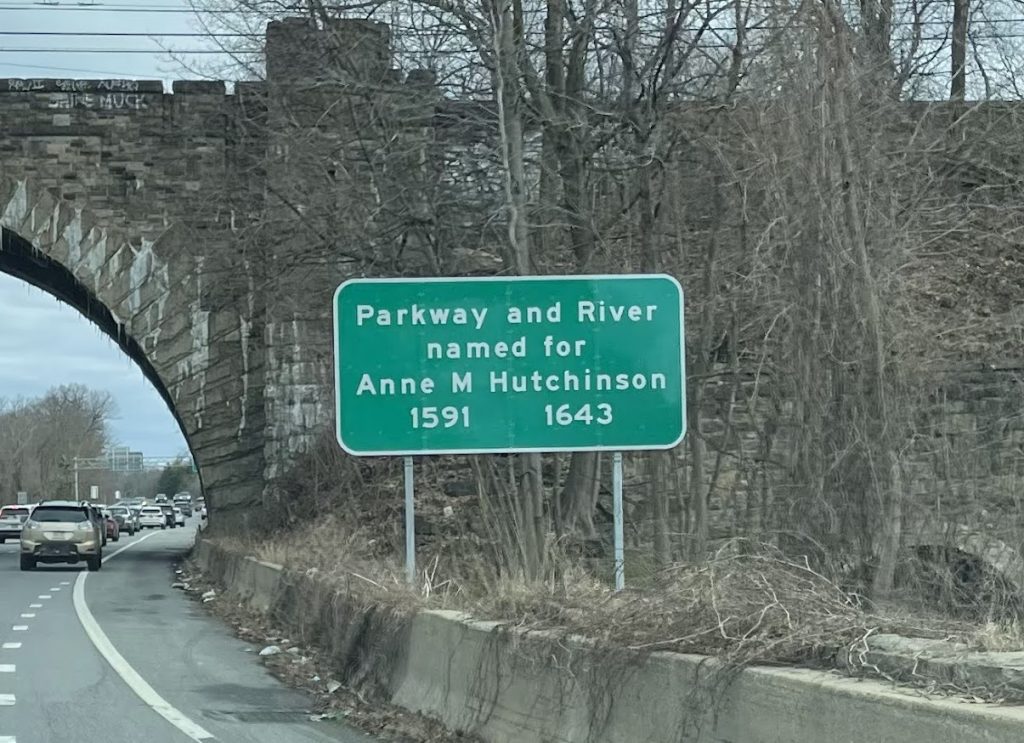The Hutchinson River Parkway in New York City is named after Anne Hutchinson, who was an early English Puritan who settled in the area that is now the Bronx during the 17th century.

Anne Hutchinson was born in England in 1591 and immigrated to Massachusetts Bay Colony with her family in 1634. She quickly became a prominent figure in the colony’s Puritan community, and she gained a reputation for her religious views and her outspoken personality.
Hutchinson’s views were controversial, and she became embroiled in a theological dispute with the colony’s leaders over the nature of salvation and the role of women in religious life. She was eventually expelled from the colony and settled in what is now the Bronx, where she founded a settlement known as Pelham Bay.
Today, Hutchinson’s legacy as a pioneering figure in the history of the Bronx is still remembered and celebrated through the naming of the Hutchinson River Parkway and other landmarks and institutions throughout the region. The parkway is an important transportation artery for the area, and it provides access to several other major highways and local businesses and attractions.
Anne Hutchinson (1591-1643) was a prominent figure in the early history of the American colonies and a key figure in the development of religious freedom in what would eventually become the United States.
Hutchinson was born in England and emigrated to the Massachusetts Bay Colony with her husband and family in 1634. She quickly became a leader in the Puritan community, organizing Bible studies and theological discussions in her home.
Hutchinson’s teachings were controversial, and she challenged the established religious leaders of the colony by advocating for a more personal and individualized relationship with God. She also spoke out against the strict religious orthodoxy of the Puritan community and advocated for greater rights and freedoms for women.
Hutchinson’s teachings drew a following, but they also drew the ire of the Puritan leaders of the colony, who saw her as a threat to their authority. In 1637, she was put on trial and charged with sedition and heresy. She was found guilty and banished from the colony, along with several of her followers.
Hutchinson settled in what is now the Bronx in New York City and founded a settlement known as Pelham Bay. She and her family were later killed in an attack by Native Americans in 1643.
Despite her tragic end, Hutchinson’s legacy as a pioneering figure in the history of religious freedom in America is still remembered and celebrated today. She is recognized as one of the earliest and most influential advocates for individual rights and freedoms in the country’s early history, and her contributions to the development of religious freedom continue to inspire and inform contemporary debates about individual rights and liberties.
The exact reason why the Hutchinson River was named after Anne Hutchinson is not clear, as there are no official records or historical documents that explain the reasoning behind the naming. However, it is likely that the river was named after Hutchinson as a way to honor her contributions to the early history of the American colonies and her legacy as a pioneering advocate for individual rights and freedoms.
Hutchinson’s teachings and beliefs were controversial and challenged the established religious and social norms of the Puritan community. Her banishment from the Massachusetts Bay Colony and her subsequent settlement in what is now the Bronx made her a notable figure in the early history of the region. The naming of the Hutchinson River after her was likely a way to recognize her contributions to the development of religious freedom and individual rights in America.
